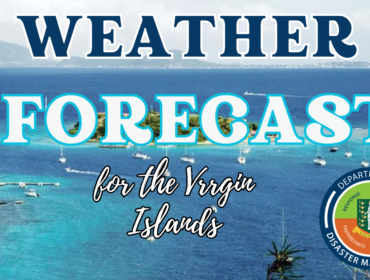14th June 2010 – The 2010 Hurricane Season has commenced with all eyes on the first Tropical Disturbance of the year, Number 10. At 10:45am, this Disturbance was located near 10.5N, 40.4W, or about 1,290 miles east of Barbados. Movement is to the WNW at about 15 mph. The current winds being produced by this system are between 20-30mph.
Forecasters expect that this Disturbance will continue moving towards the WNW over the next 5 days, bringing it very near to the Lesser Antilles around that time. If Tropical Disturbance Number 10 remains on this track, the first effects could be felt in this part of the region as early as Thursday of this week, as the outer squalls begin to move in. At that time, it is possible that this system may be at Tropical Storm strength, with gusts of between 40-50mph, and with accompanying heavy rainfall, in squalls. On this current track, it is expected that the centre of the System will be very near the Virgin Islands on Friday, and may pass to our South on Saturday 19th June, 2010.
If Tropical Disturbance Number 10 strengthens to Tropical Storm status, it shall be named “Alex.” This is of significant historic importance, as it would be the first time in 124 years, since record keeping began, that a Cape Verde storm will form in the month of June. The DDM has been in contact with the Antigua and Barbuda Meteorological Service, the National Weather Service in Puerto Rico, and our two weather information providers, Wilkens Weather Technologies and Impact Weather Inc.
In speaking with meteorologists of the National Weather Service in Puerto Rico, they suggested that Mariners, in particular, should pay very close attention to the gusty winds and high seas that may be associated with this system, as they have the potential to overturn vessels, and added that the most likely threat could be the heavy rains that this system may generate.
Current conditions in the Atlantic are extremely favourable for the development of tropical systems, especially with factors such as the presence of low wind shear. Another factor influencing Tropical Cyclone development is sea-surface temperature. In order for a cyclone to form, temperatures of at least 26.5 ° Celsius or 80 ° Fahrenheit are required. The current temperature off the Cape Verde islands, where this system is currently located is 28 degrees Celsius, with some areas at 30 degrees Celsius. One Forecaster has indicated that, with Summer still approaching, and three months of heating remaining until we reach peak temperatures in the Atlantic, ocean temperatures across the entire Caribbean, and waters between Africa and the Lesser Antilles, are about the same as they were during the peak week of water temperatures in mid-September, 2009. These conditions again provide a very favourable environment for storm formation and intensification.
Forecasters and scientists have been making efforts to improve on forecasting and warning techniques, based on lessons learned from previous hurricane impacts. NOAA has indicated that they will begin using a new hurricane scale called the Saffir-Simpson Hurricane Wind Scale this year. This new Scale will account for variables that affect Storm Surge, in an effort to better predict flooding. In the past, Storm Surge was estimated based on the Category of the storm. This method was flawed, however. The new scale will also take into account intensity, size, motion and barometric pressure, depth of near-shore area, and the topography of coastal areas. In order to demonstrate how this new scale would be used, NOAA provided the example that, in 2008, there was a 15-20 foot Storm Surge associated with Hurricane Ike, a Category 2 Storm, while the Category 4 Storm, Charlie, produced only 6-7 foot Surge. In addition to these changes by NOAA, the National Hurricane Centre has made changes to the regional alerting system. Tropical Storm and Hurricane Warnings will now be issued at 48 hours, while Tropical Storm and Hurricane Watches will be issued at 36 hours. This replaces the 36 and 24 hour time frames previously used. Based on these changes, the DDM will adjust its internal procedures and activation triggers accordingly.
In light of the Disturbance developing in the Atlantic and the heightened 2010 predictions, residents are being strongly urged to commence preparations that will last throughout the 6 months of the Hurricane Season. There are a number of actions that persons always need to consider at this time of the year. These include stocking up on essential non-perishable items, checking on your supply of medication, inspecting homes and businesses, securing personal items and important documents, determining whether there will be a need to occupy an Emergency Shelter, knowing the location of the closest, approved shelter, finalizing the Family/Business Disaster Plan, verifying your insurance coverage, trimming trees, removing debris and ensuring that items are not blocking natural waterways, such as ghuts. Persons who wish to obtain details on hurricane preparedness activities are asked to contact the DDM or visit our website at www.bviddm.com. The DDM launched its Hurricane Campaign on June 1st, which included a number of Public Service Announcements, newspaper articles and radio and television programmes. It is important that residents pay close attention to these messages.
The DDM will continue to monitor the progress of Tropical Disturbance Number 10 and will provide further updates as necessary.



